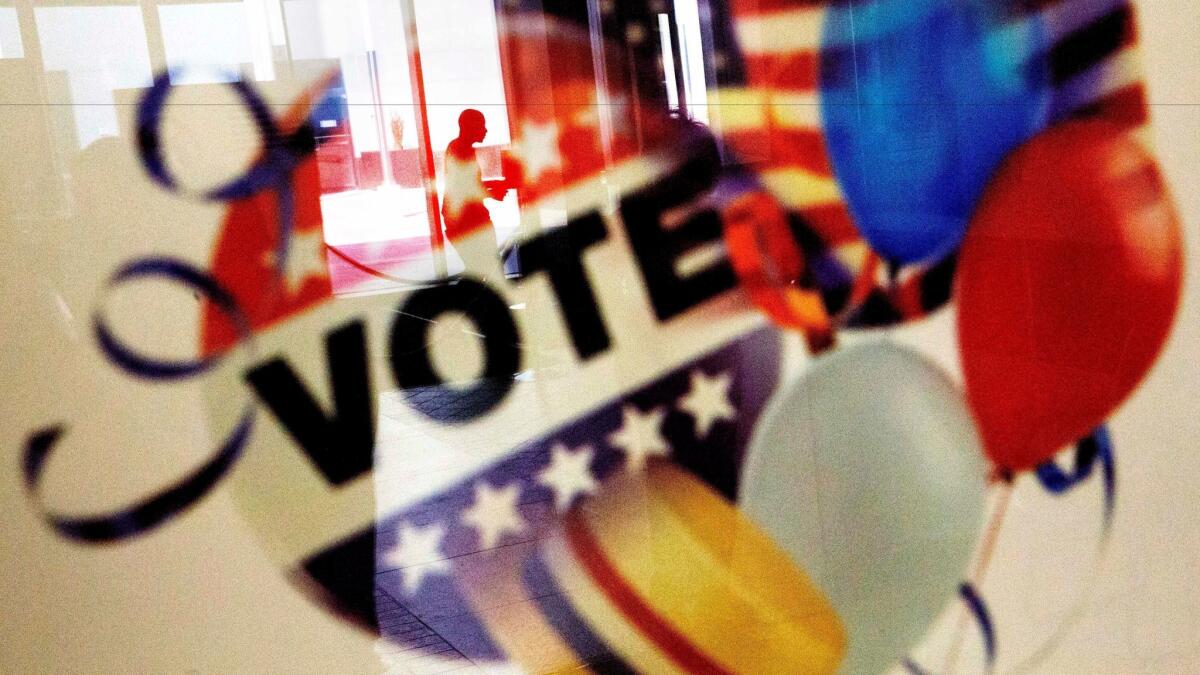Op-Ed: How to cure the electoral college

- Share via
The popular vote winner is poised to lose the presidency in the electoral college on Dec. 19, and calls are widespread to replace the college with a national popular vote. That proposal will go nowhere: Amending the Constitution is too difficult, and getting a Supreme Court judgment against the electoral college is almost as fraught. It doesn’t help that a direct presidential election is perceived as benefiting Democrats, and Republicans are ascendant at both the state and federal levels.
A simple reform, however, might go a long way toward reducing objections to the electoral college without introducing a partisan bias.
Our alternative would preserve the current arrangements for assigning electoral votes to individual states. As required by the Constitution, each state’s total electoral vote would be based on the size of its delegation in the House of Representatives (determined by population) and in the Senate (every state gets two). In most states, electoral votes are finally awarded on a winner-takes-all basis. We propose instead that electoral votes be awarded in direct proportion to each candidate’s share of the states’ popular vote.
In 2000, the EQV result would have favored George W. Bush ... while, in 2016, the EQV outcome would have awarded the presidency to Hillary Clinton.
For example, Connecticut had seven electoral votes in 2016, and 54.6% of its voters opted for Hillary Clinton while 40.9% chose Donald Trump and 4.5% chose other candidates. Under our proposal, Clinton would get 54.6% of seven, or 3.82 “electoral vote equivalents” — EQVs — from Connecticut; Trump would get 2.86 EQVs (40.9% of seven), and the remaining candidates would split 0.32 EQVs. The candidate with the largest number of EQVs amassed over the 50 states and the District of Columbia would be declared president.
This proportional-allocation scheme has many advantages that aren’t necessarily obvious until you apply it and see the results.
Here’s one: Given recent voting patterns, the EQV system wouldn’t disadvantage smaller states as a group. Small states object to a national popular vote because the current system gives their votes extra weight. The EQV reform would actually increase their importance because the formula takes into account not just the fact of victory but the margin of victory, and small-population states vote more lopsidedly than the nation as a whole.
In 2016, for example, the winning candidate in the seven least populous states defeated the runner-up by an average of 35.3 percentage points. Among the 44 larger states, the average victory margin was 15.8 points. This difference, roughly a factor of two (35.3 versus 15.8), translates into a near-doubling of the clout of the smallest states.
And yet, the EQV system would also increase the power of many big states too.
Because Clinton and Trump viewed the outcome in four of the five largest states — California, Texas, New York and Illinois — as a foregone conclusion, they mostly ignored those states. Under the EQV formula, however, even a two-point gain in California, with its 55 electoral votes, would mean as much as a similar gain in six mid-sized states. Thus the candidates would rediscover the way to San Jose, and Chicago and Fort Worth and Brooklyn.
Proportionality in the electoral college would also dispel the troubling consequences of very close winner-take-all outcomes, in which just over half the voters are exalted over the other half. Under the EQV formula, a tie would be treated as a tie, and small uncertainties in the vote count could not take on gargantuan importance (Think Florida, 2000).
EQVs would also eliminate the danger that the president would be chosen in a manner even further removed from a direct vote — by the House of Representatives. In the electoral college now, various combinations of state outcomes could give the two main candidates 269 electoral votes apiece, or a third-party candidate could keep any single competitor from getting a majority of electoral votes. In either case, the election would then be decided in the House, with each state having one vote. Such an outcome would not occur under the proposed system as the chance of the two leading candidates receiving exactly the same EQVs is essentially zero.
Finally, and perhaps most important in terms of enacting a reform, the EQV formula largely replicates the popular vote outcome without systematically benefiting one political party.
When the EQV system is applied to the state-by-state results of presidential elections since 1960, the outcome is a factor of 50 closer to the popular vote than the actual electoral college split. Yet it isn’t purely a popular vote. In 2000, the EQV result would have favored George W. Bush (who lost the popular vote by a small margin) while, in 2016, the EQV outcome would have awarded the presidency to Hillary Clinton. In effect, the EQV scheme is a neutral compromise between the electoral college and the national popular vote, each of which has a clear tendency to favor one of the two major political parties over the other.
There would be practical issues in moving to the EQV system — the states would have to pass laws to change the way they divvy electoral votes. That’s a formidable though not insurmountable challenge. Is the task worth the effort? The authors vote yes.
Arnold Barnett and Edward Kaplan are professors, respectively, at the MIT Sloan School of Management and Yale University’s schools of management, engineering and public health. They wrote about the EQV system in more detail in the American Statistical Assn.’s Chance magazine.
Follow the Opinion section on Twitter @latimesopinion and Facebook
MORE FROM OPINION
The electoral college has always been the wrong way to choose a president
The electoral college shouldn’t veto Trump’s election
A cure for the common opinion
Get thought-provoking perspectives with our weekly newsletter.
You may occasionally receive promotional content from the Los Angeles Times.






